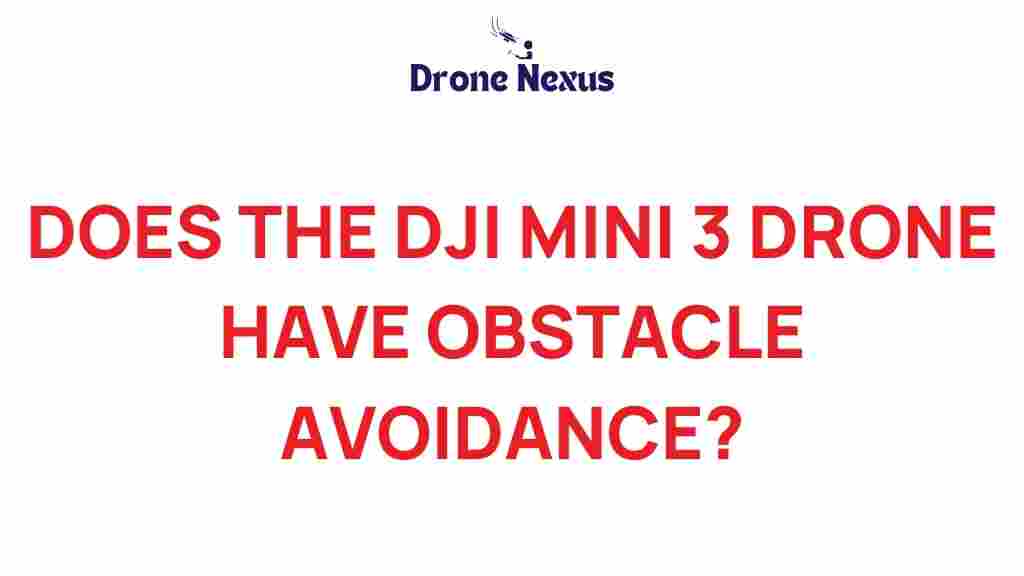Unveiling the Truth: Does the DJI Mini 3 Drone Feature Obstacle Avoidance?
The DJI Mini 3 has generated considerable buzz in the drone community, captivating both enthusiasts and casual users alike. With its compact design and impressive features, many potential buyers are eager to learn about its capabilities, particularly regarding obstacle avoidance. In this article, we will delve into whether the DJI Mini 3 is equipped with obstacle avoidance technology, its implications for users, and how it compares to other drones in the market.
Understanding Obstacle Avoidance in Drones
Obstacle avoidance is a critical feature in modern drones. It allows them to navigate around obstacles autonomously, reducing the likelihood of crashes and enhancing the user experience. Here’s how it typically works:
- Sensors: Drones are equipped with various sensors like ultrasonic, infrared, and cameras to detect obstacles in their flight path.
- Navigation Algorithms: These sensors feed data to onboard computers that use algorithms to determine the best way to avoid obstacles.
- Real-time Processing: The drone processes this data in real-time to make instant decisions while flying.
Does the DJI Mini 3 Have Obstacle Avoidance?
To answer the question directly: the DJI Mini 3 does not feature the advanced obstacle avoidance system found in its larger counterparts, such as the DJI Air 2S or the Mavic series. While it is equipped with basic safety features, it lacks the sophisticated obstacle detection and avoidance capabilities that many users may expect.
What Safety Features Does the DJI Mini 3 Offer?
Although the DJI Mini 3 does not have traditional obstacle avoidance, it still offers several safety features:
- GPS Positioning: The drone uses GPS to maintain its position and navigate effectively.
- Return to Home (RTH): In case of signal loss or low battery, the DJI Mini 3 can automatically return to its takeoff point.
- Smart Flight Modes: Features like QuickShots and Waypoints allow for easier navigation, though they don’t inherently protect against obstacles.
Why the Absence of Obstacle Avoidance?
The omission of advanced obstacle avoidance in the DJI Mini 3 is likely a design choice. Here are some reasons why DJI might have decided against including this feature:
- Size and Weight: The DJI Mini 3 is designed to be lightweight and compact. Adding complex sensors could increase weight and size.
- Target Audience: The Mini series targets entry-level drone users who may not require advanced features.
- Cost Factors: Including obstacle avoidance would raise production costs, which could lead to higher retail prices.
How to Fly the DJI Mini 3 Safely
While the DJI Mini 3 may lack advanced obstacle avoidance, you can still fly it safely by following these tips:
- Pre-flight Checklist: Always inspect your drone before flying. Check battery levels, propeller condition, and GPS signal.
- Choose Safe Locations: Fly in open areas away from people, buildings, and trees to minimize risks.
- Maintain Line of Sight: Keep your drone within your line of sight to avoid potential hazards.
- Know Your Surroundings: Familiarize yourself with the area and be aware of potential obstacles.
Comparing the DJI Mini 3 with Other Drones
When considering the DJI Mini 3, it’s essential to compare it with other models that do offer obstacle avoidance:
DJI Air 2S
The DJI Air 2S features a robust obstacle avoidance system, with sensors on all sides, making it suitable for more advanced users. Here are some key differences:
- Obstacle Avoidance: The Air 2S has advanced sensors for 360-degree obstacle detection.
- Camera Quality: The Air 2S boasts a larger sensor and better camera capabilities, ideal for professional photography.
- Flight Time: While both drones offer impressive flight times, the Air 2S may provide slightly longer durations due to its larger battery.
DJI Mini 2
The DJI Mini 2 is another excellent comparison. While it also lacks advanced obstacle avoidance, it is a step up from the original Mini:
- Camera Quality: The Mini 2 offers 4K video resolution, similar to the Mini 3.
- Flight Range: The Mini 2 has a slightly shorter flight range compared to the Mini 3.
Troubleshooting Common Issues
Even with the DJI Mini 3’s simplicity, users may encounter some common issues. Here’s a helpful troubleshooting guide:
- Drone Won’t Connect to Controller: Restart both the drone and the controller. Ensure that you are using the latest firmware.
- GPS Signal Loss: Fly in open areas away from tall buildings or trees. Ensure that the drone has a clear view of the sky.
- Battery Issues: If the drone does not respond, check the battery charge level and connections.
Conclusion
In summary, the DJI Mini 3 is an impressive drone that caters to beginner and casual users, though it lacks advanced obstacle avoidance features. While this may be a drawback for some, the Mini 3 still offers a variety of safety features that can enhance your flying experience. By following safe flying practices and understanding the limitations of your drone, you can enjoy the incredible capabilities of the DJI Mini 3.
For those looking to delve deeper into the world of drones, consider exploring this resource for comprehensive guides and tips.
Whether you’re capturing breathtaking aerial photos or simply enjoying the thrill of flying, the DJI Mini 3 remains a popular choice among drone enthusiasts. Stay informed and fly safely!
This article is in the category Technology and created by DroneNexus Team
